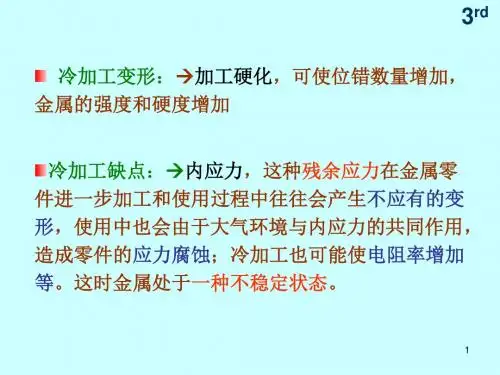第五章 回复与再结晶
- 格式:ppt
- 大小:7.70 MB
- 文档页数:68
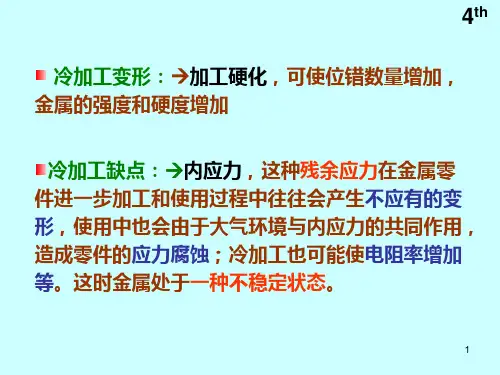
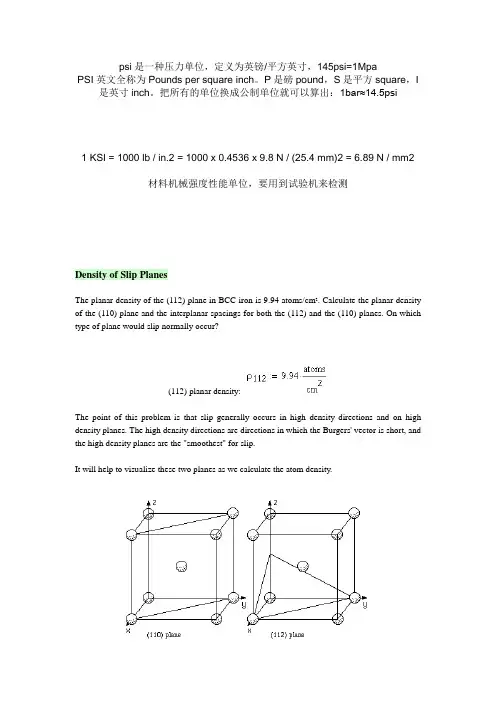
psi是一种压力单位,定义为英镑/平方英寸,145psi=1MpaPSI英文全称为Pounds per square inch。
P是磅pound,S是平方square,I 是英寸inch。
把所有的单位换成公制单位就可以算出:1bar≈14.5psi1 KSI = 1000 lb / in.2 = 1000 x 0.4536 x 9.8 N / (25.4 mm)2 = 6.89 N / mm2材料机械强度性能单位,要用到试验机来检测Density of Slip PlanesThe planar density of the (112) plane in BCC iron is 9.94 atoms/cm2. Calculate the planar density of the (110) plane and the interplanar spacings for both the (112) and the (110) planes. On which type of plane would slip normally occur?(112) planar density:The point of this problem is that slip generally occurs in high density directions and on high density planes. The high density directions are directions in which the Burgers' vector is short, and the high density planes are the "smoothest" for slip.It will help to visualize these two planes as we calculate the atom density.The (110) plane passes through the atom on the lattice point in the center of the unit cell. The plane is rectangular, with a height equal to the lattice parameter a0and a width equal to the diagonal of the cube face, which is 2 a0.Lattice parameter (height):Width:Thus, according to the geometry, the area of a (110) plane would beThere are two atoms in this area. We can determine that by counting the piece of atoms that lie within the circle (1 for the atom in the middle and 4 times 1/4 for the corners), or using atom coordinates as discussed in Chapter 3. Then the planar density isThe interplanar spacing for the (110) planes isFor the (112) plane, the planar density is not quite so easy to determine. Let us draw a larger array of four unit cells, showing the plane and the atoms it passes through.This plane is also rectangular, with a base width of √2 a0 (the diagonal of a cube face), and a height of √3 a0 (the body diagonal of a cube). It has four atoms at corners, which are counted as 1/4 for the portion inside the rectangle (4 x 1/4) and two atoms on the edges, counted as 1/2 for the portion inside the rectangle (2 x 1/2). This is a total of 2 atoms.Base width:Height:Hence, we can calculate the area and density as for the (110) plane.The planar density and interplanar spacing of the (110) plane are larger than that of the (112) plane, thus the (110) plane would be the preferred slip plane1.有一根长为5 m,直径为3mm的铝线,已知铝的弹性模量为70GPa,求在200N的拉力作用下,此线的总长度。
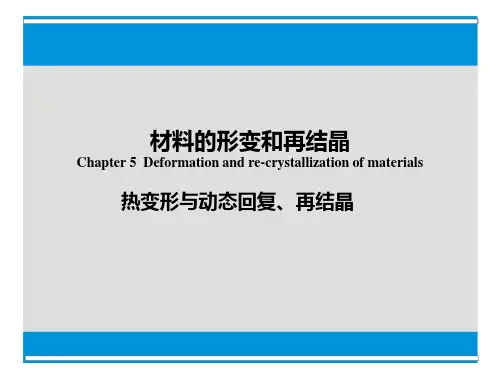
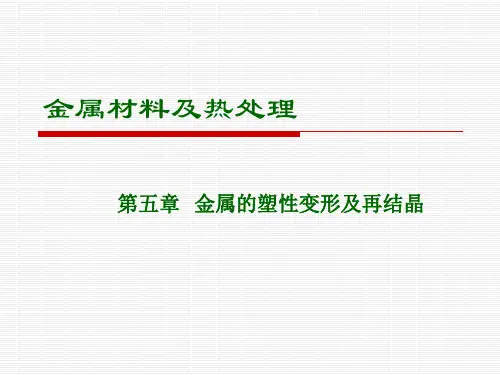






北京科技大学材料科学与工程专业814 材料科学基础主讲人:薛春阳第五章材料的形变和再结晶本章主要内容1.弹性和黏弹性2.晶体的塑性变形3.回复和再结晶4.热变形和动态回复、动态再结晶5.陶瓷形变的特点本章要求1.了解弹性和黏弹性的基本概念2.熟悉单晶体的塑性变形过程3.熟悉多晶体的塑性变形过程4.掌握塑性变形对材料组织和性能的影响5.掌握回复和再结晶的概念和过程6.熟悉动态回复和动态再结晶的概念和过程7.了解陶瓷变形的特点和一些基本概念应变应力b σsσe σbk s e ob εk ε变形的五个阶段:1.弹性变形2.不均匀的屈服变形3.均匀的塑性变形4.不均匀的塑性变形5.断裂阶段抗拉强度屈服强度弹性极限知识点1 弹性的不完整性定义:我们在考虑弹性变形的时候,通常只是考虑应力和应变的关系,而没有考虑时间的影响,即把物体看作是理想弹性体来处理。
但是,多数工程上应用的材料为多晶体甚至为非晶体,或者是两者皆有的物质,其内部存在着各种类型的缺陷,在弹性变形是,可能出现加载线与卸载线不重合、应变跟不上应力的变化等有别于理想弹性变形的特点的现象,我们称之为弹性的不完整性。
弹性不完整的现象主要包括包申格效应、弹性后效、弹性滞后、循环韧性等1.包申格效应材料预先加载才生少量的塑性变形(4%),而后同向加载则 升高,反向加载则 下降。
此现象称之为包申格效应。
它是多晶体金属材料的普遍现象。
2.弹性后效一些实际晶体中,在加载后者卸载时,应变不是瞬时达到其平衡值,而是通过一种弛豫过程来完成其变化的。
这种在弹性极限 范围内,应变滞后于外加应力,并和时间有关的现象,称之为弹性后效或者滞弹性。
3.弹性滞后由于应变落后与应力,在应力应变曲线上,使加载与卸载线不重合而是形成一段闭合回路,我们称之为弹性滞后。
弹性滞后表明,加载时消耗于材料的变形功大于卸载时材料恢复所释放的变形功,多余的部分被材料内部所消耗,称之为内耗,其大小用弹性滞后环的面积度量。
